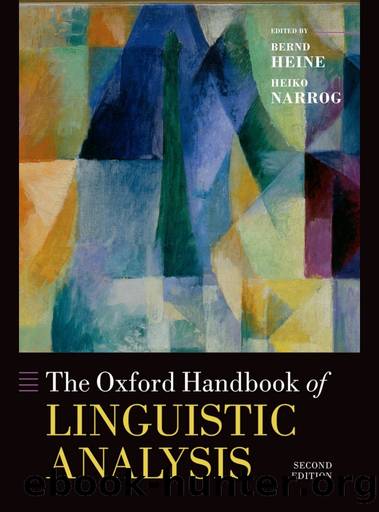The Oxford Handbook of Linguistic Analysis by Bernd Heine & Heiko Narrog

Author:Bernd Heine & Heiko Narrog [Heine, Bernd]
Language: eng
Format: azw3
Tags: Linguistics, Nonfiction, Reference
ISBN: 9780199544004
Publisher: OUP Oxford
Published: 2009-12-17T21:15:33+00:00
c h a p t e r 20
â¦â¦â¦â¦â¦â¦â¦â¦â¦â¦â¦â¦â¦â¦â¦â¦â¦â¦â¦â¦â¦â¦â¦â¦â¦â¦â¦â¦â¦â¦â¦â¦â¦â¦â¦â¦..
M O R PH O LO G I C A L
A NA LYS I S
â¦â¦â¦â¦â¦â¦â¦â¦â¦â¦â¦â¦â¦â¦â¦â¦â¦â¦â¦â¦â¦â¦â¦â¦â¦â¦â¦â¦â¦â¦â¦â¦â¦â¦â¦â¦..
geert e. booij
20.1 What is morphological analysis?
â¦â¦â¦â¦â¦â¦â¦â¦â¦â¦â¦â¦â¦â¦â¦â¦â¦â¦â¦â¦â¦â¦â¦â¦â¦â¦â¦â¦â¦â¦â¦â¦â¦â¦â¦â¦â¦â¦â¦â¦â¦â¦â¦â¦â¦â¦
Morphology is the subdiscipline of linguistics that deals with the internal structure of words. Consider the following sets of English word pairs:
(1) Verb
Noun
bake
baker
eat
eater
run
runner
write
writer
In these word pairs we observe a systematic formâmeaning correspondence: the presence of - er in the words in the right column correlates with the meaning component âone who Vsâ where V stand for the meaning of the corresponding verb in the left column. The observation of such patterns is the basis for assigning the words in the right column an internal morphological structure [[x]Vâ@r]N where the variable x stands for the phonological form of the base verb. We thus consider these nouns to be complex words. The morphological schema that generalizes over these sets of paradigmatically related words may be formalized as follows:
(2) [[x]Vâ@r]N âone who Vsâ
This schema expresses the systematic formâmeaning correspondence found in this set of word pairs. Words are signs with properties at a number of levels of the
508
geert e. booij
grammar: they have a phonological form, syntactic properties such as being a noun or a verb, a meaning, and sometimes a particular pragmatic value. Hence, morphology is not a component of the grammar on a par with phonology or
syntax. It deals not only with form, unlike what the etymology of the word suggests, but pertains to all levels of the grammar (Jackendoff, 2002). Morphology is the grammar of a natural language at the word level, and calling morphology âthe grammar of wordsâ (Booij 2007) is therefore quite appropriate.
The schema in (2) expresses a generalization based on a number of existing verbâ
nouns pairs of the relevant type. Such schemas also indicate how new complex words can be made. Indeed, the process of creating deverbal - er-nouns is quite productive in English. Morphological schemas are word-based since they express generalizations concerning established complex words. In that sense, morphology is word-based. The language user will learn these abstract schemas gradually, after having been exposed to a sufficient number of words that instantiate those schemas.
The acquisition of these schemas does not imply that the complex words on which they are based are removed from lexical memory once the schemas have been
acquired. Schemas co-exist with the complex words that instantiate these schemas (Bybee 1988 b, 1995). Hence, the grammar exhibits redundancy, which is no problem given the vastness of human memory. The wrong assumption that the existence of a rule excludes listing outputs of that rule is referred to as the rule-list fallacy (Langacker 1987 b).
In morphological analysis we also make use of the notion âmorphemeâ, tradi-
tionally defined as the minimal meaning-bearing unit of a language. The word baker, for instance, might be said to consist of the lexical morpheme bake and the bound morpheme - er. However, the systematic paradigmatic relationships between words may also be signaled by other means than morpheme concatenation, such as stem alternation, reduplication, stress, and tone patterns.
Download
This site does not store any files on its server. We only index and link to content provided by other sites. Please contact the content providers to delete copyright contents if any and email us, we'll remove relevant links or contents immediately.
Cecilia; Or, Memoirs of an Heiress — Volume 1 by Fanny Burney(32434)
Cecilia; Or, Memoirs of an Heiress — Volume 2 by Fanny Burney(31871)
Cecilia; Or, Memoirs of an Heiress — Volume 3 by Fanny Burney(31854)
The Lost Art of Listening by Michael P. Nichols(7406)
Asking the Right Questions: A Guide to Critical Thinking by M. Neil Browne & Stuart M. Keeley(5633)
We Need to Talk by Celeste Headlee(5542)
On Writing A Memoir of the Craft by Stephen King(4863)
Dialogue by Robert McKee(4321)
Pre-Suasion: A Revolutionary Way to Influence and Persuade by Robert Cialdini(4145)
I Have Something to Say: Mastering the Art of Public Speaking in an Age of Disconnection by John Bowe(3840)
Elements of Style 2017 by Richard De A'Morelli(3307)
The Book of Human Emotions by Tiffany Watt Smith(3238)
Fluent Forever: How to Learn Any Language Fast and Never Forget It by Gabriel Wyner(3028)
Name Book, The: Over 10,000 Names--Their Meanings, Origins, and Spiritual Significance by Astoria Dorothy(2939)
Good Humor, Bad Taste: A Sociology of the Joke by Kuipers Giselinde(2903)
Why I Write by George Orwell(2874)
The Art Of Deception by Kevin Mitnick(2736)
The Grammaring Guide to English Grammar with Exercises by Péter Simon(2710)
Ancient Worlds by Michael Scott(2624)
